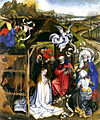Musée des Beaux-Arts (Dijon)
The Musée des Beaux-Arts (German: "Museum of Fine Arts") in Dijon is one of the oldest museums in France . It houses works of art from ancient Egyptian times to the 20th century. It is located in the east wing of the former palace of the Dukes of Burgundy . The focus of the collection is on Burgundian art from the late Middle Ages, French sculpture and painting from the 17th, 18th and 19th centuries, and works by regional artists.
history
The art museum is located together with the town hall in the former Palace of the Dukes of Burgundy ( Palais des ducs de Bourgogne ) and the Palace of the Estates of Burgundy ( Palais des Etats de Bourgogne ).
Philip the Bold moved into the ducal palace in 1364 and Philip the Good had the 52 m high tower, which is still named after him, built ( Tour Philippe Le Bon ). The palace kitchens, which are a masterpiece of secular Gothic architecture, have also been preserved from the time of the Dukes of Burgundy . In 1477 Burgundy came to France by inheritance and the palace was used by the French kings from then on. At the end of the 17th century, Jules Hardouin-Mansart undertook extensive renovations and extensions to the Palace of the Estates before a drawing school first moved here in 1787, which was founded by François Devosge in 1766 .
The museum opened its doors to the public in 1799, initially with two rooms in the east wing of the palace. In addition to the statues hall dedicated to the sculptures, there was the Condé salon , which was reserved for painting. Works by the Prix de Rome scholarship holders and paintings confiscated during the French Revolution came to the exhibition. In the reign of Napoleon I , the museum received additional assignments of works of art through the Chaptal decree, and the museum was later able to expand its collections with the support of the French state, so that the museum expanded into the palace of the Dukes of Burgundy. 1827 convicted Févret de Saint-Mémin the tombs of the Dukes of Burgundy from the Carthusian Monastery of Champmol to the palace. Later on, private donations and bequests were made, with particular emphasis on the Trimolet, Joliet and Granville collections.
collection
Two large altars also come from the Carthusian monastery of Champol, of which the sections painted by Melchior Broederlam are particularly significant in terms of art history. The museum owns a major work by an artist by Conrad Witz with the panel of Emperor Augustus and Sibylle de Tibur . There is also a birth of Christ by Robert Campin and paintings by the Italian artists Lorenzo Lotto , Paolo Veronese , Jacopo Pontormo and Guido Reni . Flemish and Dutch painting is represented by works by Peter Paul Rubens and Jan Brueghel the Elder and Frans Hals . One of the outstanding paintings in the French department is the lady at the toilet of the master of the Fontainebleau school. The museum also houses works by Philippe de Champaigne , Charles Le Brun , Jean-Marc Nattier , Jean Baptiste Greuze , Hubert Robert and Jean-Baptiste Oudry . Caravaggio's influence on French painting is illustrated by the painting Boy blowing into a lamp by Georges de la Tour .
The importance of local artistic production is illustrated by the painters Jean Tassel and Philippe Quantin and the baroque sculptor Jean Dubois . The Dijon drawing school produced such important artists as Jacques-André Naigeon and Pierre Paul Prud'hon , some of whom the museum owns, as well as the sculptor Emmanuel Frémiet and the cabinet maker Hugues Sambin .
The collection with French artists of the 19th century is also extensive. These include Théodore Géricault , Gustave Moreau , William Adolphe Bouguereau , Eugène Ernest Hillemacher and James Tissot . There are also paintings by the impressionists Claude Monet , Alfred Sisley and Édouard Manet from the legacy of the doctor Albert Robin , from whom the museum owns the painting Gartenallee in Rueil , the pastel Méry Laurent with a black hat and other works. The Granville donation brought works by the Cubist painters Georges Braque and Juan Gris to the museum. Other 20th century artists are Georges Rouault and Nicolas de Staël .
The museum also has a large collection of drawings and an extensive arts and crafts department. In 1998 a separate hall was opened for the collection of ancient Egyptian art. Statuettes, amulets, a sarcophagus and mummy portraits are exhibited here.
Gardensaal ("Salle des Gardes")
The Gardensaal, the most famous room in the museum, houses the tombs of the Dukes of Burgundy from the Chartreuse de Champmol . Between 1385 and 1410, Jean de Marville , Claus Sluter and Claus de Werve worked on the tomb of Philip II the Bold . Particularly noteworthy are the arcades of the base with 41 mourning people ( pleurants ). The later double tomb for Johann Ohnefurcht and his wife Margarete imitates the tomb of Philip II. In the same room there are also two winged altars that were commissioned for the monastery of Champmol.
Exhibited works of art
Konrad Witz :
Emperor Augustus and Sibylle de Tibur
literature
- Emmanuel Starcky, Sophie Barthélémy, Rémi Cariel: Le Musée des Beaux-Arts de Dijon. Paris 2002, ISBN 2-7118-4472-2 .
- Exhibition catalog L 'art à la cour de Bourgogne: le mécénat de Philippe Le Hardi et de Jean sans Peur (1360-1420): les princes des fleurs de lis. Paris 2004, ISBN 2-7118-4728-4 .
Web links
Footnotes
- ↑ Information on the Musée des Beaux-Arts in the database of the Bibliothèque nationale de France .
Coordinates: 47 ° 19 ′ 17.6 ″ N , 5 ° 2 ′ 33.6 ″ E













